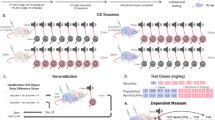Abstract
Psychotropic drugs such as methadone, morphine and bulbocapnine produce increments in dopamine metabolism as an unconditioned reflex. When a buzzer noise is used as a conditioned stimulus (CS) with these drugs as unconditioned stimuli, the buzzer CS acquires the properties of the drugs in increasing dopamine metabolism. These results suggest that the brain, like other visceral organs, can be conditioned in terms of neurotransmitter release or metabolism.
Similar content being viewed by others
References
Collins, K. H. and Tatum, A. L.: A conditioned salivary reflex established by chronic morphine poisoning.Am. J. Physiol. 74:14, 1925.
Costa, E., Spano, P. F., Groppetti, A., Algeri, S., and Neff, N. H.: Simultaneous determinations of trytophan, tyrosine, catecholamines and serotonin specific activity in rat brain.Atti. Accad. Med. Lombardo 23:1100, 1968.
Dolin, A. O.: Uslovno reflektorne Katalepticheskoe sostoianie (Conditioned reflex cataleptic condition).Zh vyssh. nerv. Deyat. Pavlova 1:485, 1951.
Gantt, W. H., Reflexology, Schizokinesis and Autokinesis.Cond. Reflex. 1:57, 1966.
Gessa, G. L., Di Chiara, G., Tagliamonte, A., and Pérez-Cruet, J.: Evidence that methadone inhibits dopamine receptors in brain, 5th Internat. Congress on Pharmacology. Free abstract communications, 1972; p. 77.
Kobayashii, R. M., Palkovits, M., Jacobowitz, D. M., and Kopin, I. J.: Biochemical mapping of the noradrenergic projection from the locus coeruleus.Neurology 25:223, 1975.
Laverty, R. and Taylor, K. M.: The fluorometric assay of catecholamines and related compounds. Improvements and extension of the hydroxyindole techniques.Anal. Biochem. 22:269, 1968.
Meisch, R. A. and Thompson, T.: Ethanol as a reinforcer: Effects of fixed ratio size and food deprivation.Psychopharmacologia 28:171, 1973.
Mello, N. K. and Mendelson, J. H.: Operant performance by rats for alcohol reinforcement: A comparison of alcohol-preferring and non-preferring animals.Quart. J. Stud. Alcohol 25:226, 1964.
Pérez-Cruet, J. and Gantt, W. H.: Conditioned catalepsy to bulbocapnine: Cardiac, respiratory and motor components.Fed. Proc. 18:468, 1959.
Pérez-Cruet, J. and Gantt, W. H.: Conditional reflex electrocardiogram to bulbocapnine: Conditioning of the T wave.Am. Heart J. 67:61, 1964.
Pérez-Cruet, J.: Cardio-respiratory components of conditional catalepsy to bulbocapnine. Neurophannacology, Excerpta Medica. Congress Series No. 129, Editor H. Brill, 1967; p. 912.
Pérez-Cruet, J., Gessa, G. L., Tagliamonte, A., and Tagliamonte, P.: Evidence for a balance in basal ganglia between cholinergic and dopaminergic activity.Fed. Proc. 30:216, 1971.
Pérez-Cruet, J., DiChiara, G., and Gessa, G. L.: Accelerated synthesis of dopamine in the rat brain after methadone. Experientia28:926, 1972.
Pérez-Cruet, J.: Conditioned reflex changes in dopamine metabolism induced by methadone as a conditioned reflex.In J. M. Singh and H. Lal (Eds.): Drug Addiction, 1974; p. 249.
Pérez-Cruet, J., Thoa, N. B., and Ng, L. K. Y.: Acute effects of heroin and morphine on newly synthesized serotonin in rat brain.Life Sci. 17: 349, 1975.
Pert, C. B. and Snyder, S. H.: Opiate receptor: Demonstration in nervous tissue.Science 179:1011, 1973.
Pickens, R. and Harris, W. C.: Self-administration of d-amphetamine by rats.Psychopharmacologia 12:158, 1968.
Post, R. M., Kotin, J., Goodwin, F. K., and Gordon, E. K.: Psychomotor activity and cerebrospinal fluid amine metabolites in affective illnesses.Am. J. Psychiat. 130:67, 1973.
Post, R. M. and Goodwin, F. K.: Simulated behavior states: An approach to specificity in psychobiological research.Biol. Psychiat. 7:237, 1973.
Roffman, M., Reddy, C., and Lal, H.: Control of morphine-withdrawal hypothermia by conditioned stimuli.Psychopharmacologia 29:197, 1973.
Sasame, H., Pérez-Cruet, J., DiChiara, G., Tagliamonte, A., Tagliamonte, P., and Gessa, G. L.: Effect of methadone on dopamine metabolism in rat basal ganglia and its relation to catalepsy.Riv. Farmacol. Terap. 11:99, 1971.
Sasame, H., Pérez-Cruet, J., DiChiara, G., Tagliamonte, A., Tagliamonte, P., and Gessa, G. L.: Evidence that methadone blocks dopamine receptors in the brain.J. Neurochem. 19:1953, 1972.
Schuster, C. R.: Psychological approaches to opiate dependence and selfadministration by laboratory animals.Fed. Proc. 29:2, 1970.
Sedvall, G. C., Weise, V. K., and Kopin, I. J.: The rate of norephinephrine synthesis measuredin vivo during short intervals: Influence of adrenergic nerve impulse activity.J. Pharmacol. Exp. Ther. 159:274, 1968.
Tagliamonte, A., Spano, P. F., Mazzucato, P., and Gessa, G. L.: Método par ’lestrazione e il dosaggio dell’ácido omovanílico nei tessuti.Boll. Soc. Ital. Biol. Sper. 44:420, 1967.
Thompson, T. and Pickens, R.: Stimulus Properties of Drugs. New York, Appleton-Century-Crofts, 1971.
Ungerstedt, U.: Stereotaxic mapping of the monoamine pathways in the rat brain.Acta Physiol. Scand. (Suppl.),367:1, 1971.
Wilder, A. and Pescor, F. T.: Classical conditioning of a morphine-abstinence phenomenon, reinforcement of opioid-drinking behavior and “relapse” in morphine-addicted rats.Psychopharmacologia (Berl.) 10:255–284, 1967.
Woods, J. H. and Schuster, C. R.: Reinforcing properties of morphine, cocaine and SPA as a function of unit dose.Internat. J. Addictions 3:231, 1968.
Author information
Authors and Affiliations
Additional information
These investigations were done while the author was a research associate in the Pharmacology Research Associate Program, NIGMS, in the Laboratory of Chemical Pharmacology, NIH, Bethesda from 1969 to 1971, and as a medical director, USPHS, Section of Psychiatry, the Laboratory of Clinical Science, NIMH, Bethesda, Md. (1971 to 1973).
Rights and permissions
About this article
Cite this article
Pérez-Cruet, J. Conditioning of striatal dopamine metabolism with methadone, morphine or bulbocapnine as an unconditioned stimulus. Pav. J. Biol. Sci. 11, 237–250 (1976). https://doi.org/10.1007/BF03000317
Issue Date:
DOI: https://doi.org/10.1007/BF03000317




